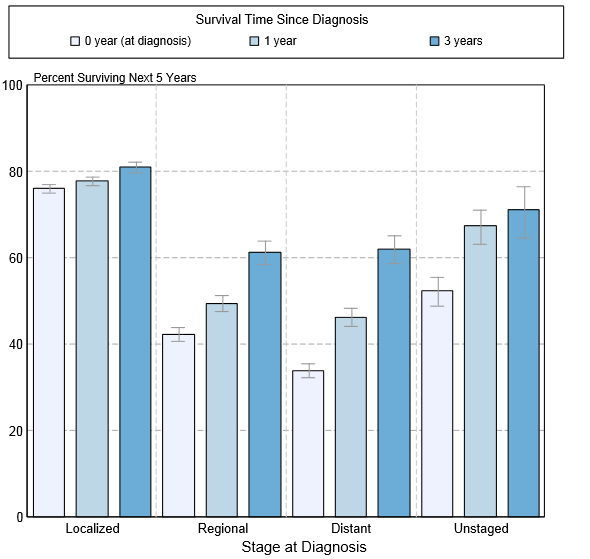Laryngeal cancer natural history, complications and prognosis
|
Laryngeal cancer Microchapters |
|
Diagnosis |
|---|
|
Treatment |
|
Case Studies |
|
Laryngeal cancer natural history, complications and prognosis On the Web |
|
American Roentgen Ray Society Images of Laryngeal cancer natural history, complications and prognosis |
|
FDA on Laryngeal cancer natural history, complications and prognosis |
|
CDC on Laryngeal cancer natural history, complications and prognosis |
|
Laryngeal cancer natural history, complications and prognosis in the news |
|
Blogs on Laryngeal cancer natural history, complications and prognosis |
|
Risk calculators and risk factors for Laryngeal cancer natural history, complications and prognosis |
Editor-In-Chief: C. Michael Gibson, M.S., M.D. [1] Associate Editor(s)-in-Chief: Faizan Sheraz, M.D. [2]
Overview
Natural history
- If left untreated, hypopharyngeal cancer produces few symptoms early in the course.
- Once the tumor has expanded from its site of origin, it may obstruct the aerodigestive passages.
Complications
- Airway obstruction
- Disfigurement of the neck or face
- Loss of voice and speaking difficulties
- Metastasis
Prognosis
Throat cancers can be cured in 90% of patients if detected early. If the cancer has spread to surrounding tissues or lymph nodes in the neck, 50 - 60% of patients can be cured. If the cancer has metastasized to parts of the body outside the head and neck, the cancer is not curable and treatment is aimed at prolonging and improving quality of life. After treatment, patients generally need therapy to help with speech and swallowing. A small percentage of patients (5%) will not be able to swallow and will need to be fed through a feeding tube.
5-Year Survival
- Between 2004 and 2010, the 5-year relative survival of patients with laryngeal cancer was 62.6%.[1]
- When stratified by age, the 5-year relative survival of patients with laryngeal cancer was 61.5% and 58.2% for patients <65 and ≥ 65 years of age respectively.[1]
- The survival of patients with laryngeal cancer varies with the stage of the disease. Shown below is a table depicting the 5-year relative survival by the stage of laryngeal cancer:[1]
| Stage | 5-year relative survival (%), (2004-2010) |
| All stages | 60% |
| Localized | 75.1% |
| Regional | 43.4% |
| Distant | 35.1% |
| Unstaged | 55.7% |
- Shown below is an image depicting the 5-year conditional relative survival (probability of surviving in the next 5-years given the cohort has already survived 0, 1, 3 years) between 1998 and 2010 of laryngeal cancer by stage at diagnosis according to SEER. These graphs are adapted from SEER: The Surveillance, Epidemiology, and End Results Program of the National Cancer Institute.[1]
References
- ↑ 1.0 1.1 1.2 1.3 Howlader N, Noone AM, Krapcho M, Garshell J, Miller D, Altekruse SF, Kosary CL, Yu M, Ruhl J, Tatalovich Z,Mariotto A, Lewis DR, Chen HS, Feuer EJ, Cronin KA (eds). SEER Cancer Statistics Review, 1975-2011, National Cancer Institute. Bethesda, MD, http://seer.cancer.gov/csr/1975_2011/, based on November 2013 SEER data submission, posted to the SEER web site, April 2014.
